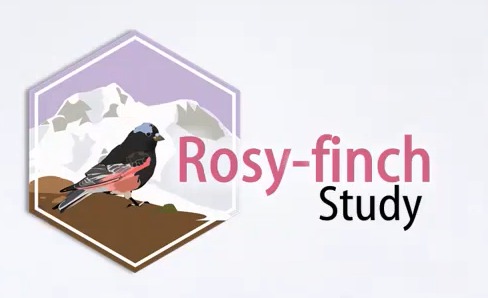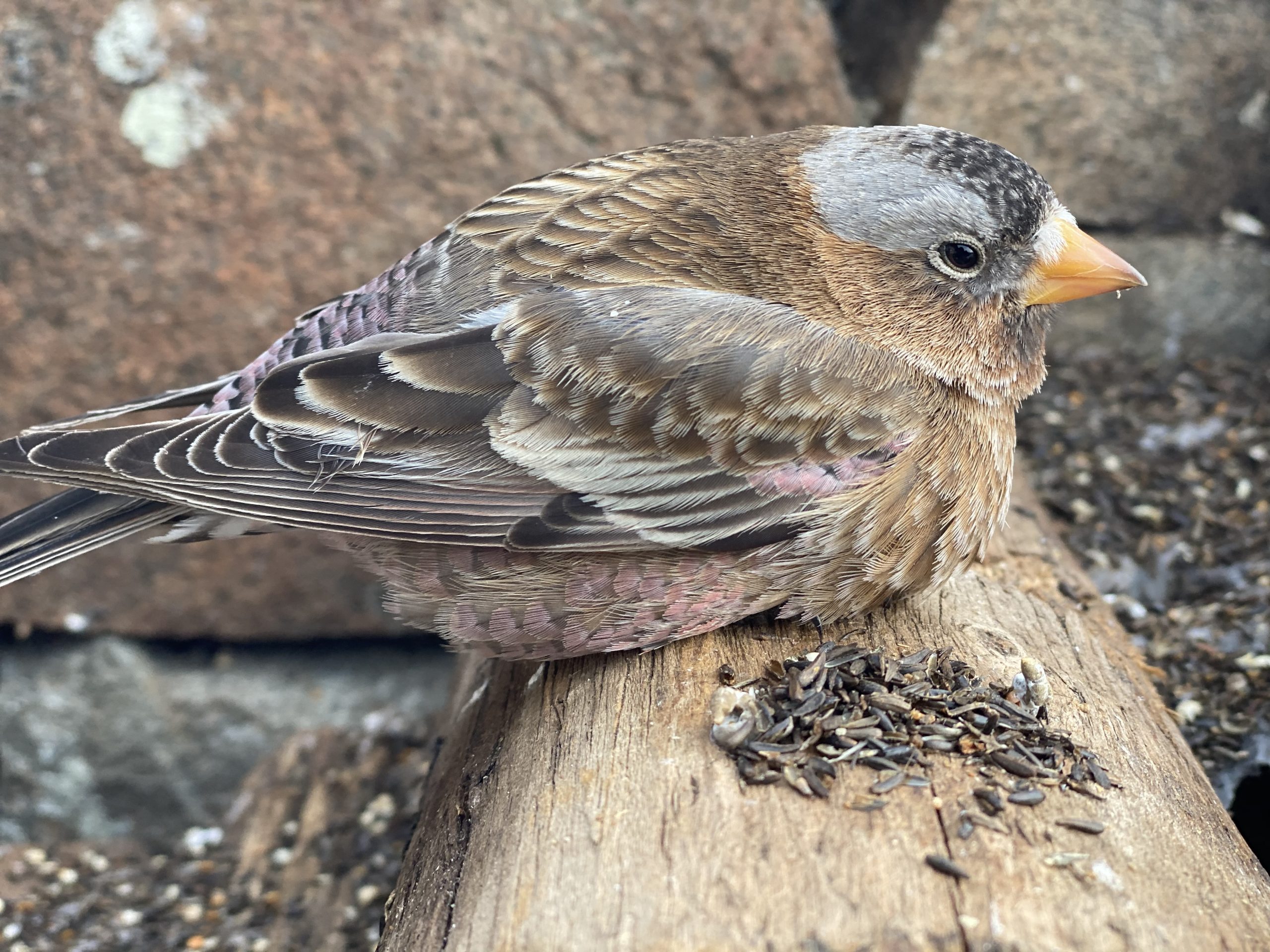Author Dr. Lynne Spriggs O’Connor: Three hundred gray-crowned rosy-finches drop from their high perch on the old tall cottonwood tree by the pond, free-falling one after another, riding the air like waves on the ocean, to feed again along the snowy stone wall. Yesterday while I was hiking up into higher mountains of the adjoining National Forest along the creek, a small group of about forty passed overhead. Back at home, I scatter seeds outside the kitchen while preparing breakfast, lunch, and dinner. The larger flock seems to observe our daily habits and sync up. Sharing mealtimes with wild birds is a treat! We admire our feathered guests while they eat beside us, all winter long, just on the other side of glass windows. Sometimes, like today, I can’t resist being even closer. Slowly, quietly, I turn the latch of the glass door to step outside and feel the cool fresh snowy air of this gray Spring morning. With a strong WHIRRR of wings, a majority of the birds rise. They speak soft chew chew chew chews flying overhead. I respond with quiet words.
“Good morning! I’m so glad to see you.”
About thirty finches stay. Though I stand just three feet away, these steady individuals continue eating along the wall, listening and watching. The larger group has perched back atop the old cottonwood. From across the pond, I whistle to them with my own two-note call, then wait.
It is impossible to describe the awe and the swell of tenderness one feels when nearly three hundred songbirds instantly drop, one by one in rapid succession from on high, and fly directly back to you, in response to your call. Such rhapsody! In the next moment, the entire wall and surrounding ground become filled again to capacity with dear friends who happen to be birds. Friends who will soon leave us to make their secretive nests in the highest of rocky cliffs to our north, where they will lay eggs in soft beds lined with fine grasses, porcupine hair, white-tailed Ptarmigan feathers, mountain goat wool. I remain still, listening to the peaceful sounds of our cold-weather companions, now eating en masse all around me. I speak softly, careful not to disturb, when I gradually back into the kitchen and close the door while three hundred finches continue to eat.
Experiences like these feel dreamlike in their afterglow.
“What joy” I say, resuming a seat next to my husband. “It’s so bittersweet, knowing they’ll be gone soon.”
Mid-March is when the impending absence of these winter finches begins to hang heavy in our hearts. Yet last year our flock stayed longer than usual, right through April’s potent mix of snowstorms, hail, thunderstorms, and sunshine. Red-winged blackbirds had already arrived. I remember our excitement in seeing their rosy colors intensify with the build-up to mating. During the final part of April and into early May of 2020, from these same windows in our kitchen observatory, we were treated to five amazing days of grand finale performances.
Flight patterns became even more muscular, more fervent, and more operatic than usual. A group of some four hundred took to flying a circumference between our feeding porch and the old cottonwood tree, over and over, round and round. Their energy is hypnotic. Regular rhythmic wing beats made it look like they were swimming aerial laps. Is this how a migratory bird builds stamina? Do these circular flights inform the group of what is coming? At other times, we imagined the flock readying themselves for higher altitudes as they cast farther and ever higher, traveling way up into the sky until they vanished.

Then suddenly, from one evening to the next morning, only a core group of about forty finches showed up for seed. This small group stayed with us for one more week until May 6th before they, too, took leave for higher altitudes.
During this volatile month of March, when our valley typically experiences the most intense winter weather, we wake each morning to check on our flock. Is today the day they will be gone? Before heading down to help with calving at the barn, we take extra good care of our bird friends. We make sure they have plenty of sustenance for the long trip ahead. We wish them well.
I used to be more of a migratory bird myself. Before moving to Montana in 2003, I traveled back and forth between New York City and Montana for many years, returning each summer to spend time on the Blackfeet Reservation as a part of doctorate fieldwork. My body always tingled with excitement while traveling those last twelve miles from Browning to East Glacier, driving straight into the base of the Rocky Mountain front. This year’s flock of gregarious gray-crowned rosies will soon gather and ready themselves to leave our valley until next November. I wonder if their bodies tingle with excitement when they rise and return to their favorite mountain peaks high in the clouds.
Dr. Lynne Spriggs O’Connor is a writer and rancher. She has written several blogs here for FiRN named Finches of Cloudland, and her upcoming memoir is titled Elk Love: A Montana Memoir, where she writes about her special relationship with the Rosy-Finches that have visited her and her husband over the years.
FiRN is committed to researching and protecting these birds and other threatened finch species as well. We’ve included a link to donate below, and hope you’ll help support our efforts. We hope to expand to Rosy-Finches across Eurasia too.


